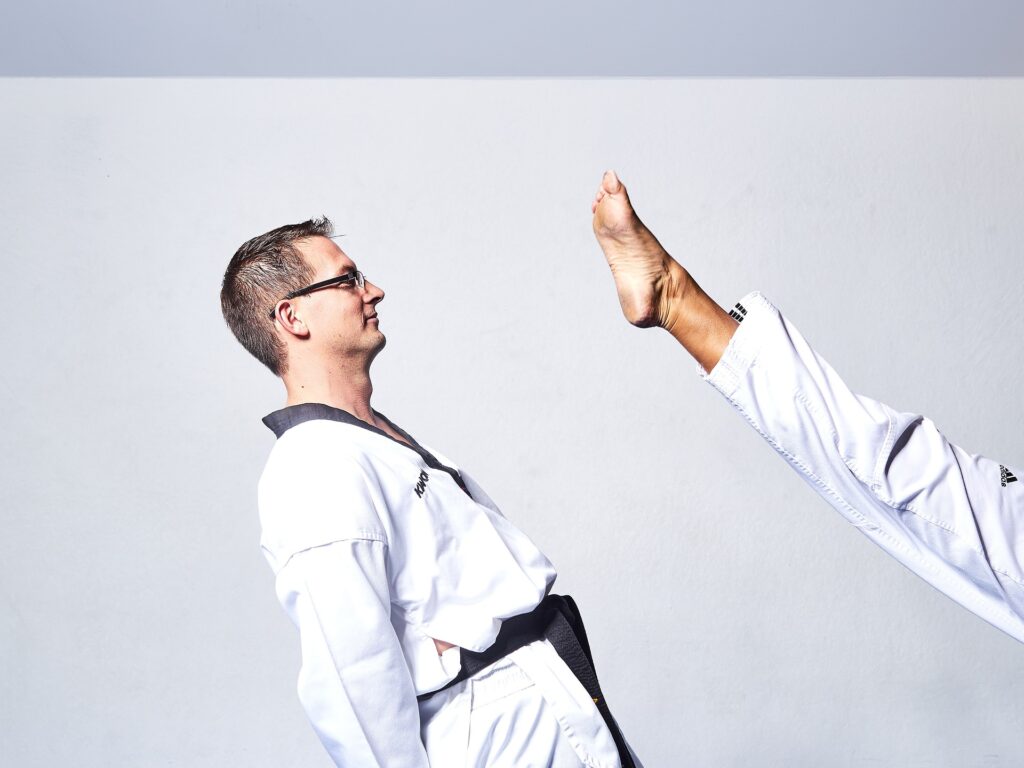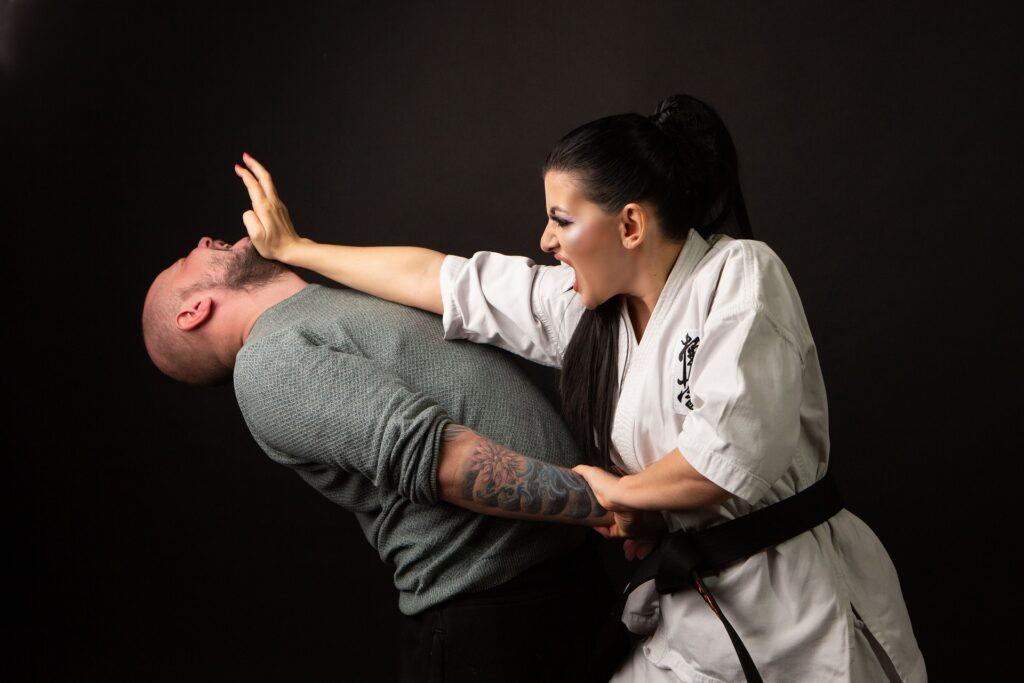Once you choose to take martial arts classes, you will have two main options: Karate and Taekwondo. Maybe you’ve heard about Karate from the famous Mr. Myagi, but Taekwondo is usually not as well-known.
Karate is a type of martial art that comes from Japan, while Taekwondo originated in Korea. The main difference between them is that Karate uses more hand moves and Taekwondo focuses more on kicking. Even though they are both martial arts, Karate emphasizes self-defense while Taekwondo involves competing in tournaments.
Karate and Taekwondo are both martial arts that can help you protect yourself if needed. Taekwondo usually involves lots of jumping and spinning kicks, while Karate focuses more on simple but reliable strikes that don’t leave much room for mistakes. Both styles also include defensive tactics and require lots of mental focus to master.
Karate vs Taekwondo
Are you unsure of the difference between two options and which one is better for you? Take some time to think it through and decide which one is the best fit.
Karate – A History
For centuries, the practice of Karate has been attributed to the island of Okinawa in Japan. According to many people, this martial art began when King Shoha, who was ruling at that time, forbade weapons on the island in an effort to prevent war. In response, citizens developed a method of self-defense through hand-to-hand combat. Over time, this practice evolved into what is currently known as Karate.
Karate is a martial art with both Chinese and Japanese roots. It began with Funakoshi Gichin, born in 1868, who dedicated his entire life to teaching Karate throughout Japan. He is widely recognized as the master of Karate, as it was his work that exposed the two cultures to one another.
His disciples continued his legacy, forming the Japan Karate Association (JKA) in 1949 to spread his particular type of martial arts.
In 1945, the first-ever karate dojo in the United States opened its doors to martial artists who wished to learn and practice the art. This space has served as a catalyst for karate’s expansion across the globe and continues to be a vital part of its evolution. There are several distinct styles of karate that have emerged over time, with some of the most popular being Shotokan, Wado-ryu, Shito-ryu, Goju-Ryu and Kyokushin.
Taekwondo – A History
Taekwondo is a martial art that has a long history, with records showing it was practiced as far back as 50 B.C.E in Korea. The name of the art comes from three words: Tae, meaning to kick; Kwon, meaning to punch or destroy; and Do, meaning a way of doing something. When combined, Taekwondo can be translated as “the way of using your entire body to defend oneself”.
When Japan annexed Korea in the early 1900s, they outlawed the practice of martial arts such as Taekwondo. Despite this, some people still trained in secret while others ventured to Japan or China to learn. Consequently, Taekwondo was changed by the influence of Judo, Kung Fu, and Karate which had been introduced to Korea.
In 1955, Kwan masters held a conference in order to bring together various styles of martial arts. Through their collaborative efforts, they created a unified form of combat that they named Taekwondo. The hybrid style incorporated elements from Karate, such as kicking techniques, as well as hand techniques borrowed from Chinese martial arts. Together, these components formed an effective system of self-defense.

Karate vs Taekwondo – The Differences
Taekwondo and Karate can appear quite alike to somebody just starting out in the world of martial arts. However, when you delve deeper into their equipment, moves, and regulations, it is easy to see how they are actually distinct.
Techniques
Karate is a martial art that is renowned for its striking techniques, such as kicking, punching, and open-handed strikes. It also involves joint manipulation, vital point striking, grappling, and throws which are taught in class. This type of fighting enables individuals to subdue their opponent through two main methods: kicking and striking.
Karate is a martial art that requires both physical and mental fortitude. The name “Karate” translates literally to “empty hands” and refers to the fact that this system of self-defense does not involve any weapons. To become proficient in Karate, practitioners must undergo rigorous physical training to gain strength, speed and agility. Timing and balance are also key components so mental discipline must be cultivated as well.
Taekwondo is a popular form of martial arts, distinguished from Karate by its focus on kicking techniques. This is due to the leg being the strongest and longest weapon a martial artist has, enabling effective powerful strikes. Taekwondo offers not just self-defense benefits but also physical fitness opportunities.
Taekwondo promotes physical fitness by developing speed, strength, flexibility, balance, and stamina. It also encourages mental discipline by requiring the practitioner to concentrate on technique. The practice of Taekwondo is a combination of physical and mental training.
Martial Arts Styles
Taekwondo is practiced in two distinct styles. Kata, similar to karate, is a set of martial arts moves that are prearranged and executed. The second form is sparring, which is full contact combat using a blend of offensive and defensive actions against an opponent.
Karate is a martial art with basic and fundamental movements that comprise of the Three K: Kata, Kihon, and Kumite. Kihon are the basics which form the foundation of style and art and include stances, punches, blocks and kicks.
Kata is a pattern of movements that must be memorized. Training with kata involves honing speed, technique, direction, rhythm, and power.
Kata can give us more than just an understanding of self-defense in practical life. Similar to how Kihon is our vocabulary, kata could be considered the grammar of karate. Practicing this set of movements helps build balance and control while also teaching one how to maintain the right distance when striking a target. With consistent repetition and application, kata can help sharpen your self-defense skills and make them applicable in real-world scenarios.
Kumite is the final part of Karate, which involves sparring or working with a partner. This is beneficial as it allows practitioners to become accustomed to performing techniques such as kicks, blocks, punches and strikes in a safe and regulated setting. Partner work provides an ideal opportunity to rehearse these maneuvers.
Practicing kumite can help to hone your self-defense capabilities by putting your counterattacks and defensive postures to the test in real-world scenarios. This is a great way to measure one’s martial arts prowess, as it involves combining the fundamental techniques of karate (Kihon) with its choreographed movements (kata).
Competition Ruleset
Karate competitions have straightforward rules when it comes to scoring. A point is given when a technique that has the right amount of power, speed, focus, and control lands on specific body parts: head, neck, face, chest, side, abdomen or back. Furthermore, extra points are earned if an individual performs multiple techniques in sequence.
- Good form
- Accurate distance
- Vigorous application
- Good timing
- Awareness
- Sporting attitude
Competitors in martial arts can be given points for their attacking techniques. A Jodan kick or a move performed on an opponent who is already down will get the highest score of three, while mid-level kicks are worth two points and punches at the mid to upper level will earn one point.
Scoring for taekwondo is straightforward. Kicks to the head score three points, while spinning kicks to the body earn two. Basic attacks on the torso are worth one point. The fighter who accumulates more points than their adversary by the end of a round is declared victorious.
When electronic scoring is not in use, for head kicks four judges must push a button when they observe a scoring point. A point is given when three of the judges concur with the strike.
Equipment
A Taekwondo uniform is typically white and called a do bok. A colored belt, which indicates the student’s rank, is worn around the waist.
The belt colors progress in the following order: white, yellow, green, blue, red and finally black. Black belts are then given “dan” grades as they advance in ability and knowledge.
Karate competitors must wear a plain traditional gi. Belt colors are used to indicate rank, and stripes on the belt signify progress within that rank.
Protective gear for combat sports includes body armor, foot protection, a mouth guard, and shin guards. A groin guard may also be worn, but it is not required.
Karate vs Taekwondo – Self Defence, Which is Better?
Karate and Taekwondo are two martial arts that share a common lineage. In terms of rank and form, they have only slight differences between them. Both offer an excellent workout while keeping self-defense as the primary objective. Karate focuses more on building strength, power and stability through solid stances whereas Taekwondo emphasizes mobility, speed and flexibility. Although both involve strikes, kicks and blocks, there is a distinct difference in how these techniques are performed: Karate uses muscle power to execute moves while Taekwondo requires precision and technique.
Karate emphasizes both hand and foot techniques, while Taekwondo is mainly concerned with kicks. Practically speaking, Karate has a greater emphasis on street self-defense without the need for intense training for competition, whereas Taekwondo is more focused on tournament performance.

Martial Arts vs. Karate & Taekwondo
Karate and Taekwondo are two distinct styles of martial arts that have been around for many years. Each style has its own set of techniques and rules, as well as a unique history. While they both involve the use of punches, kicks, and other forms of physical contact, the way in which these techniques are performed is different. Additionally, each style has its own philosophy and training techniques. Therefore, while they are both part of the larger category of martial arts, Karate and Taekwondo are very distinct from one another.
Should You Learn Karate or Taekwondo?
When deciding between Karate and Taekwondo, it is important to consider their different focuses. Karate is known for its strong punches and strikes, while Taekwondo emphasizes agility and kicking techniques. Both martial arts provide great physical exercise, making them suitable for boys and girls alike. Ultimately, the choice of which one is best suited for an individual comes down to personal preference.
